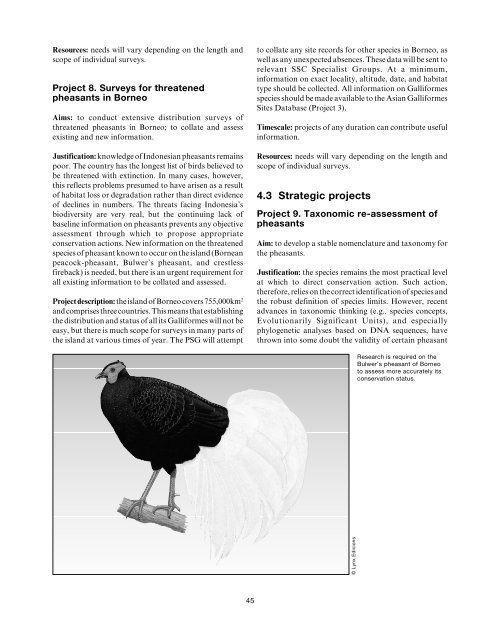Pheasants: Status Survey and Conservation Action Plan ... - IUCN
Pheasants: Status Survey and Conservation Action Plan ... - IUCN
Pheasants: Status Survey and Conservation Action Plan ... - IUCN
You also want an ePaper? Increase the reach of your titles
YUMPU automatically turns print PDFs into web optimized ePapers that Google loves.
Resources: needs will vary depending on the length <strong>and</strong><br />
scope of individual surveys.<br />
Project 8. <strong>Survey</strong>s for threatened<br />
pheasants in Borneo<br />
Aims: to conduct extensive distribution surveys of<br />
threatened pheasants in Borneo; to collate <strong>and</strong> assess<br />
existing <strong>and</strong> new information.<br />
Justification: knowledge of Indonesian pheasants remains<br />
poor. The country has the longest list of birds believed to<br />
be threatened with extinction. In many cases, however,<br />
this reflects problems presumed to have arisen as a result<br />
of habitat loss or degradation rather than direct evidence<br />
of declines in numbers. The threats facing Indonesia’s<br />
biodiversity are very real, but the continuing lack of<br />
baseline information on pheasants prevents any objective<br />
assessment through which to propose appropriate<br />
conservation actions. New information on the threatened<br />
species of pheasant known to occur on the isl<strong>and</strong> (Bornean<br />
peacock-pheasant, Bulwer’s pheasant, <strong>and</strong> crestless<br />
fireback) is needed, but there is an urgent requirement for<br />
all existing information to be collated <strong>and</strong> assessed.<br />
Project description: the isl<strong>and</strong> of Borneo covers 755,000km 2<br />
<strong>and</strong> comprises three countries. This means that establishing<br />
the distribution <strong>and</strong> status of all its Galliformes will not be<br />
easy, but there is much scope for surveys in many parts of<br />
the isl<strong>and</strong> at various times of year. The PSG will attempt<br />
to collate any site records for other species in Borneo, as<br />
well as any unexpected absences. These data will be sent to<br />
relevant SSC Specialist Groups. At a minimum,<br />
information on exact locality, altitude, date, <strong>and</strong> habitat<br />
type should be collected. All information on Galliformes<br />
species should be made available to the Asian Galliformes<br />
Sites Database (Project 3).<br />
Timescale: projects of any duration can contribute useful<br />
information.<br />
Resources: needs will vary depending on the length <strong>and</strong><br />
scope of individual surveys.<br />
4.3 Strategic projects<br />
Project 9. Taxonomic re-assessment of<br />
pheasants<br />
Aim: to develop a stable nomenclature <strong>and</strong> taxonomy for<br />
the pheasants.<br />
Justification: the species remains the most practical level<br />
at which to direct conservation action. Such action,<br />
therefore, relies on the correct identification of species <strong>and</strong><br />
the robust definition of species limits. However, recent<br />
advances in taxonomic thinking (e.g., species concepts,<br />
Evolutionarily Significant Units), <strong>and</strong> especially<br />
phylogenetic analyses based on DNA sequences, have<br />
thrown into some doubt the validity of certain pheasant<br />
Research is required on the<br />
Bulwer’s pheasant of Borneo<br />
to assess more accurately its<br />
conservation status.<br />
© Lynx Edicions<br />
45
















